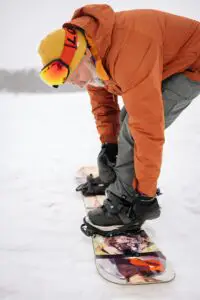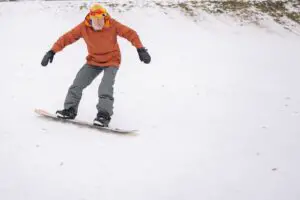Are you curious if you can still hit the slopes during early pregnancy? Well, we’ve got some answers for you.
Staying active during this special time can be beneficial, but it’s important to understand the risks involved with snowboarding while pregnant.
This article will explore everything from assessing your fitness level to safety precautions and alternative activities.
Plus, we’ve gathered expert advice to help you make informed decisions about enjoying your love for snowboarding while caring for yourself and your baby.
Let’s dive in!
Key Takeaways
- Staying active during early pregnancy improves overall well-being, alleviates common discomforts, boosts mood and energy levels, and promotes better sleep.
- Snowboarding while pregnant carries risks such as an increased risk of miscarriage due to falls or accidents, negative impact on fetal development from jolting movements, and decreased oxygen levels at high altitudes.
- Snowboarding can negatively impact fetal development by increasing the risk of falls, reducing fetal oxygen supply, and stressing the placenta.
- It is important for expecting mothers to prioritize safety, avoid high-risk activities, engage in low-risk exercises recommended by healthcare providers, and assess their fitness level before considering snowboarding.
The Benefits of Staying Active During Early Pregnancy
Staying active during early pregnancy can help improve your overall well-being and alleviate common discomforts. Engaging in regular physical activity is beneficial for both you and your baby. It can help boost your mood, increase energy levels, and promote better sleep.
Additionally, staying active can help reduce the risk of gestational diabetes, high blood pressure, and excessive weight gain. Exercise also improves circulation, which can prevent swelling and varicose veins. Choosing low-impact activities safe for pregnancy, such as walking, swimming, or prenatal yoga, is important.
Always listen to your body and consult your healthcare provider before starting any new exercise routine. Remember to stay hydrated and wear comfortable clothing while physically active during this special time.
Understanding the Risks of Snowboarding While Pregnant
If you’re considering snowboarding while pregnant, it’s important to understand the potential risks involved.
One of the main concerns is the increased risk of miscarriage due to falls or accidents on the slopes. Additionally, the impact and jolting movements experienced during snowboarding can potentially negatively affect fetal development.
To ensure your safety and that of your baby, it’s recommended to take necessary precautions and consult with your healthcare provider before engaging in any winter sports activities.
Snowboarding and Miscarriage Risk
You should be aware that snowboarding during early pregnancy may increase the risk of miscarriage. Prioritizing your and your baby’s health during this crucial time is important.
Snowboarding involves physical exertion, balance, and potential falls or collisions, which can strain your body and potentially harm the developing fetus. The impact of falls or sudden movements could lead to complications or injury.
Additionally, snowboarding at high altitudes can decrease oxygen levels, negatively affecting the baby’s development.
It is recommended to consult with your healthcare provider before engaging in any physical activity during pregnancy, including snowboarding.
They can provide personalized advice based on your specific circumstances and help you make an informed decision, prioritizing your and your baby’s well-being.
Impact on Fetal Development
It’s crucial to prioritize the health and development of your baby. Engaging in physical activities like snowboarding during pregnancy can potentially harm the fetus. Here are three reasons why you should avoid snowboarding while pregnant:
Increased risk of falls: Snowboarding requires balance and coordination, which can be affected by pregnancy hormones. This increases the risk of falls and injuries that could impact you and your baby.
- Decreased oxygen supply: Snowboarding at high altitudes can reduce fetal oxygen supply, affecting its growth and development.
- Impact on placenta: The jarring movements involved in snowboarding can stress the placenta, potentially disrupting its function and compromising nutrient delivery to your baby.
To ensure a healthy pregnancy, it’s best to refrain from snowboarding or other high-impact physical activities until after giving birth. Prioritize safety for yourself and your unborn child by choosing low-risk exercises your healthcare provider recommends.
Safety Precautions for Expecting
When expecting, it’s important to prioritize safety by following recommended guidelines for physical activity.
While snowboarding can be a thrilling sport, it is generally advised to avoid high-risk activities during early pregnancy. The American College of Obstetricians and Gynecologists recommends engaging in moderate-intensity exercises, such as brisk walking or swimming, for at least 150 minutes per week.
These activities are considered safe and beneficial for your and your baby’s health. However, snowboarding involves rapid movements, balance challenges, and potential falls that may harm the developing fetus.
It is crucial to consult with your healthcare provider before participating in any physically demanding activities during pregnancy. They will provide personalized guidance based on your circumstances to ensure your and your baby’s safety throughout this time.
Tips for Assessing Your Fitness Level for Snowboarding
Assess your fitness level for snowboarding by considering factors such as strength, endurance, and balance. These three aspects are crucial in determining your ability to handle the physical demands of snowboarding.
Strength: Snowboarding requires a certain level of muscular strength, particularly in the legs, core, and upper body. Building strength through exercises like squats, lunges, and push-ups will improve your overall performance on the slopes.
Endurance: Snowboarding can be physically taxing, so having good cardiovascular endurance is essential. Engaging in activities such as running or cycling will help improve your stamina and allow you to enjoy longer sessions on the mountain.
- Balance: Maintaining balance is key when navigating slopes and performing tricks. Incorporating exercises that challenge your stability, like yoga or balance board training, will enhance your ability to stay upright while snowboarding.
Safety Precautions to Consider Before Hitting the Slopes
Before hitting the slopes, make sure to familiarize yourself with safety precautions. These measures are essential to ensure your safety and reduce the risk of accidents while snowboarding.
One necessary precaution is wearing a helmet. Wearing a helmet can protect your head from injuries in falls or collisions.
Another vital precaution is checking your equipment. It is essential to check your equipment before each session to ensure it is in good condition and functioning properly. This includes checking bindings, edges, and boots for any signs of wear or damage.
In addition to wearing a helmet and checking your equipment, you should know weather conditions and slope difficulty levels before starting your snowboarding adventure.
Modifications and Alternative Activities for Snowboarding Enthusiasts
Modifications are available if you’re looking for alternative snowboarding activities, such as adaptive snowboarding or trying different winter sports. Here are three options to consider:
Adaptive Snowboarding: This modification allows individuals with physical disabilities to enjoy the thrill of snowboarding. Adaptive equipment and techniques are used to accommodate different abilities.
Cross-Country Skiing: This low-impact activity provides a great cardiovascular workout, allowing you to explore scenic winter landscapes at your own pace.
- Snowshoeing: Strap on snowshoes and embark on a serene winter hike through snowy trails. It’s a fantastic way to connect with nature and experience the beauty of winter firsthand.
Whether you’re looking for an adrenaline rush or simply want to stay active during the winter months, these alternative activities offer exciting ways to enjoy the snowy season while staying safe and having fun.
Expert Advice on Snowboarding During Early Pregnancy
If you’re an avid snowboarder and are in the early stages of pregnancy, it’s natural to wonder if you can continue pursuing your passion on the slopes. While it’s essential to prioritize your health and safety during this special time, there isn’t a one-size-fits-all answer to whether or not you can snowboard during early pregnancy.
Expert advice is recommended; every woman’s body and pregnancy journey is unique. Factors such as your overall health, fitness level, and any potential risks associated with snowboarding need to be considered.
Consulting with your healthcare provider is crucial to making an informed decision prioritizing your well-being and your growing baby’s well-being.
They can provide specific guidance based on your circumstances, ensuring a safe and enjoyable pregnancy experience while maintaining a connection with the activities you love.
Listening to Your Body: Signs to Stop Snowboarding During Pregnancy
When it comes to physical risks while pregnant, being self-aware and listening to your body is essential. Your changing body puts you at a higher risk for certain injuries, such as falls or strains.
Physical Risks While Pregnant
You should be aware of the physical risks involved in snowboarding while pregnant. While hitting the slopes may be tempting, prioritizing your safety and your baby’s well-being is crucial. Here are three critical physical risks you should consider:
Increased risk of falls: Snowboarding involves fast-paced movements and balancing on a board, increasing the chances of losing balance and falling. This poses a significant risk to both you and your baby.
Abdominal trauma: Falls or collisions can lead to direct impact on your abdomen, potentially causing harm to your developing fetus.
- Changes in blood flow: Snowboarding requires intense physical exertion, which can elevate your heart rate and increase blood pressure. These changes in blood flow may affect oxygen supply to the placenta.
Considering these risks, you should consult your healthcare provider before engaging in winter sports during pregnancy. Your health and the health of your baby should always come first.
Importance of Self-Awareness
Being self-aware of the potential risks and limitations before participating in any winter sports while pregnant is crucial.
While snowboarding can be an enjoyable and exhilarating activity, it is crucial to consider your safety and the well-being of your unborn child.
Snowboarding involves physical exertion, balancing on a board, and the risk of falls or collisions. These factors can strain your body and potentially harm your baby.
Additionally, the changing center of gravity during pregnancy may affect your balance and coordination, increasing the risk of accidents.
It is recommended to consult with your healthcare provider before engaging in any winter sports during pregnancy. They can provide personalized advice based on your health status and help you decide about participating in snowboarding or other activities.
Frequently Asked Questions
Can Snowboarding During Early Pregnancy Affect the Development of the Baby?
Snowboarding during early pregnancy may potentially affect the development of the baby. It is essential to consult with your healthcare provider for personalized advice on whether or not it is safe for you to participate in this activity.
Is It Safe to Snowboard During the First Trimester of Pregnancy?
During the first trimester of pregnancy, it is not recommended to snowboard. Your baby’s development is crucial during this time, and the risk of falls or injuries could be harmful. It’s best to prioritize your health and safety.
Are There Any Specific Exercises or Stretches I Should Do Before Snowboarding During Pregnancy?
Before snowboarding during pregnancy, it’s important to do specific exercises and stretches that can help prepare your body. Consult with a healthcare provider for guidance on safe and suitable activities.
Can Snowboarding During Pregnancy Increase the Risk of Miscarriage?
Snowboarding during early pregnancy does not increase the risk of miscarriage. It’s essential to consult with your healthcare provider for personalized advice, but staying active and maintaining balance generally can be beneficial.
What Are Some Alternative Activities I Can Do Instead of Snowboarding While Pregnant?
You can consider alternative activities during early pregnancy instead of snowboarding. Various options like swimming, walking, prenatal yoga, or low-impact exercises can provide exercise and promote your well-being.
Conclusion
While staying active during early pregnancy has numerous benefits for the mother and the baby, it is important to understand the risks associated with snowboarding.
Assessing your fitness level and consulting with a healthcare professional before hitting the slopes is recommended. Safety precautions should be considered, and modifications or alternative activities may be necessary for snowboarding enthusiasts.
Listening to your body and recognizing signs to stop snowboarding during pregnancy is crucial. Remember, it’s all about prioritizing the health and well-being of you and your baby.




